Discover 11 hidden attractions, cool sights, and unusual things to do in Gadsden (United States). Don't miss out on these must-see attractions: Noccalula Falls Park, Forrest Cemetery, and Gilliland-Reese Covered Bridge. Also, be sure to include Greater Gadsden Area Tourism in your itinerary.
Below, you can find the list of the most amazing places you should visit in Gadsden (Alabama).
Table of Contents
Noccalula Falls Park

Waterfall in Alabama. Noccalula Falls Park is a 250-acre public park located in Gadsden, Alabama, United States. The main feature of the park is a 90-foot waterfall. Trails wind through Black Creek Gorge past caves, an aboriginal fort, an abandoned dam, pioneer homestead, and Civil War carvings. The park also features a petting zoo, mini-golf course, the Gilliland-Reese Covered Bridge and a replica 1863 C. P. Huntington train ride.
Noccalula Falls Park was listed on the Alabama Register of Landmarks and Heritage on May 12, 1976. It was rated in 2017 as the best campsite in Alabama in a 50-state survey conducted by Msn.com.
The falls drop itself has been run successfully in whitewater kayaks on multiple occasions, beginning in late November 2011 when three expert kayakers ran the drop. The water level was unusually high, permitting a deep enough pool to form at the base of the falls. Local law enforcement has since issued citations to paddlers for running the falls, as the state does not consider this stretch a state-owned water bottom.
The Noccalula Falls Botanical Gardens displays over 25,000 azaleas.[1]
Address: 1500 Noccalula Falls Park, 35999 Gadsden
Forrest Cemetery
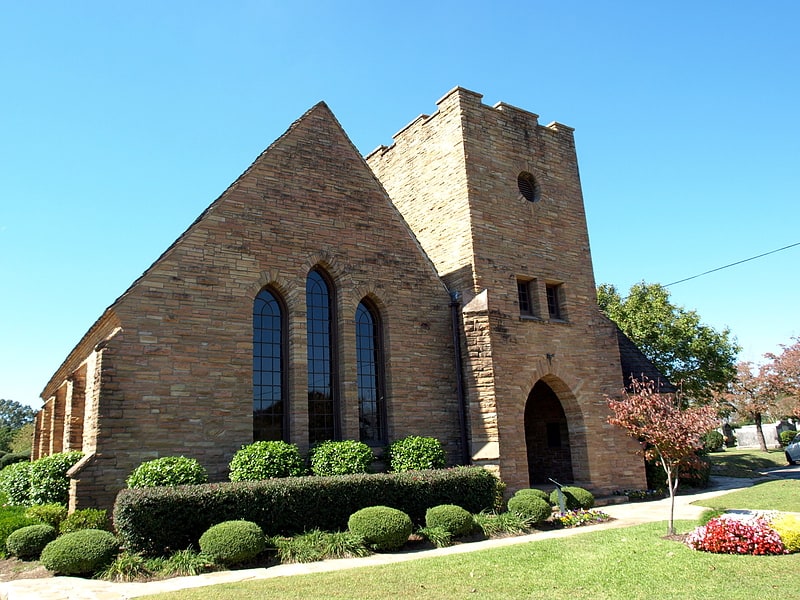
Historical landmark in Gadsden, Alabama. The Forrest Cemetery Chapel and Comfort Station are historic structures in Gadsden, Alabama. The chapel, comfort station, and cemetery gates were built in 1935 by workers from the Works Progress Administration, and designed by local architect Paul W. Hofferbert, who also designed the Legion Park Bowl. The chapel is designed in Gothic Revival style, with a steeply pitched gable with three lancet arched windows and a square tower with lancet arch opening for the entrance. The front gate columns and wall are connected to a hipped roof comfort building, which originally housed restrooms, but is now used for storage. All three are constructed of rough-cut sandstone blocks quarried from nearby Lookout Mountain. The buildings were listed on the Alabama Register of Landmarks and Heritage in 1988 and the National Register of Historic Places in 1992.[2]
Gilliland-Reese Covered Bridge
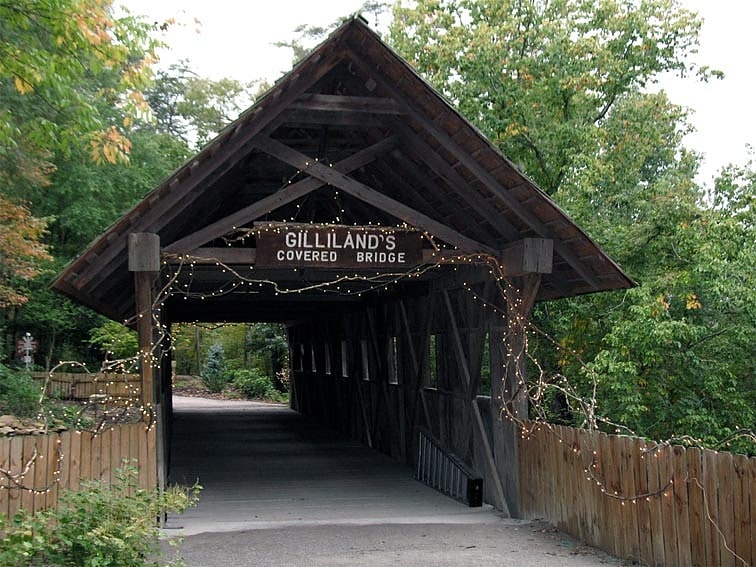
Bridge. The Gilliland-Reese Covered Bridge, more simply known as Gilliland's Covered Bridge, is a locally owned wooden covered bridge that spans a small pond near Black Creek in Etowah County, Alabama, United States. It is located at Noccalula Falls Park off Noccalula Road in the city of Gadsden. Coordinates are 34°02′21.79″N 86°01′26.93″W. Noccalula Falls Park is also home to the 90-foot Noccalula Falls, part of Black Creek as it cascades down into a ravine from a ledge off Lookout Mountain. There are a couple of sources which state the bridge spans Clayton Fish Pond, but that is over a mile west of the park along a rural section of Hinds Road.
Built in 1899, the 85-foot (26 m) bridge is a Stringer construction over a single span. Its current WGCB number is 01-28-C, formerly 01-28-02. Although most sources spell the second part of the name as "Reese," it is actually named after the town of Reece City where the bridge was originally located. There is an admission charge to visit Noccalula Falls Park (Noccalula Falls itself is excluded), which also includes a pioneer village along with a botanical garden. The bridge is maintained by the City of Gadsden.[3]
Greater Gadsden Area Tourism
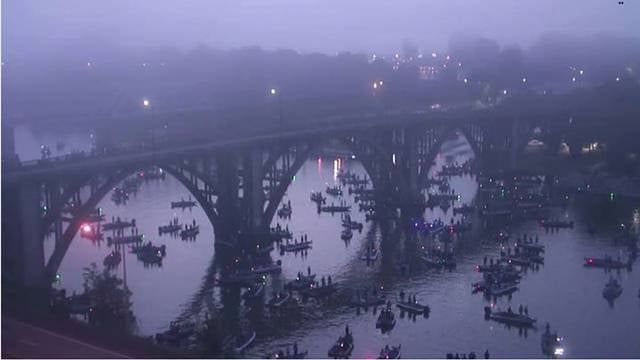
Relax in park, Park, Visitor center, Area
Address: 90 Walnut St, 35901-5255 Gadsden
The Walnut Gallery
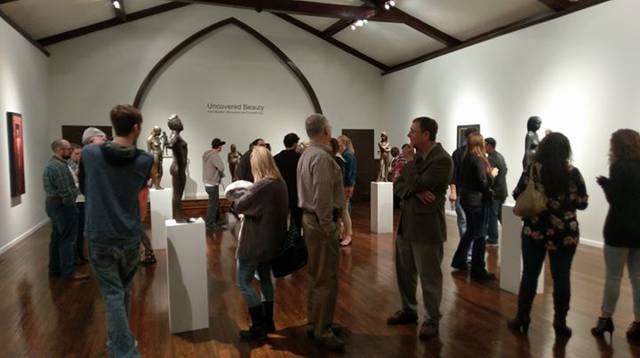
Art gallery, Shopping, Museum
Address: 806 Walnut St, 35901-4037 Gadsden
United States Post Office
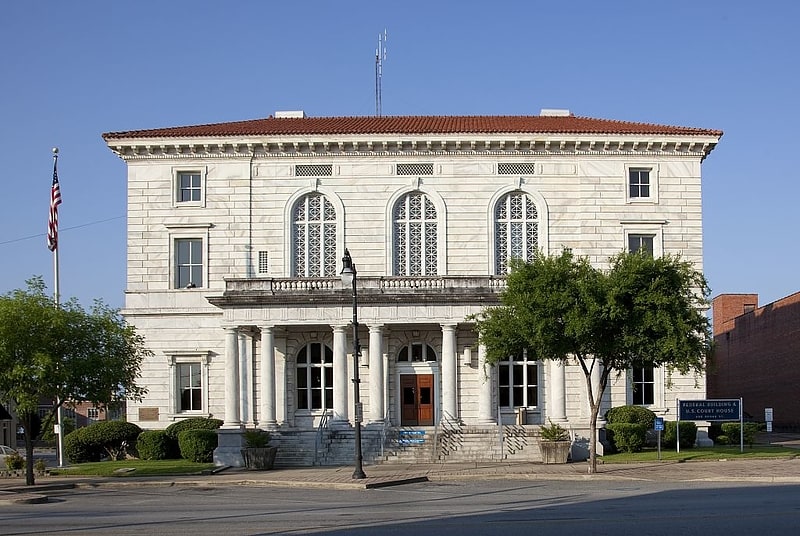
Post office in Gadsden, Alabama. The U.S. Post Office, also known as the Federal Building and Courthouse, is a historic government building in Gadsden, Alabama.[4]
Gadsden Times-News Building
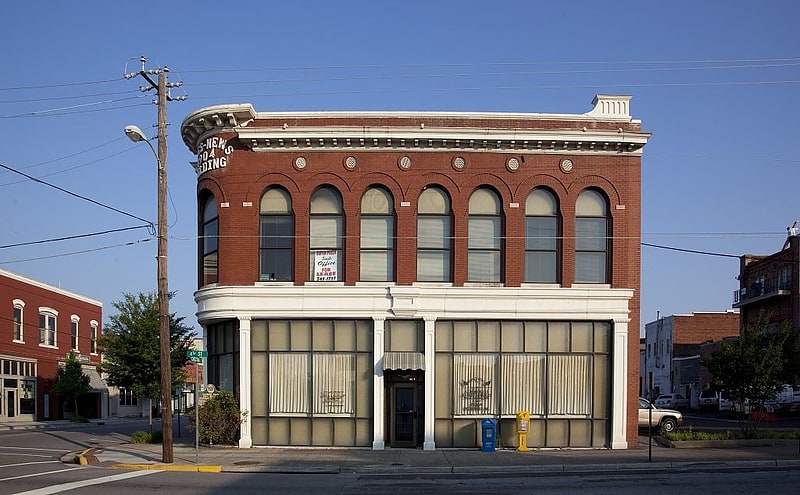
Building in Gadsden, Alabama. The Gadsden Times-News Building is a historic building in Gadsden, Alabama. It was built by the owners of The Gadsden Times-News in 1904. After changing their name to The Gadsden Times in 1924, the paper moved its operation to another building in 1927. It has since housed a variety of commercial businesses. The two-story building is brick and rounded on the street corner. The 4th Street ground-level façade has cast iron pilasters and entablature, with large windows surrounded by smaller panes. The second floor has a series of arched one-over-one sash windows and a cornice with heavy modillions, which is raised on the curve. The building was listed on the Alabama Register of Landmarks and Heritage in 1982 and the National Register of Historic Places in 1983.[5]
Mort Glosser Amphitheater
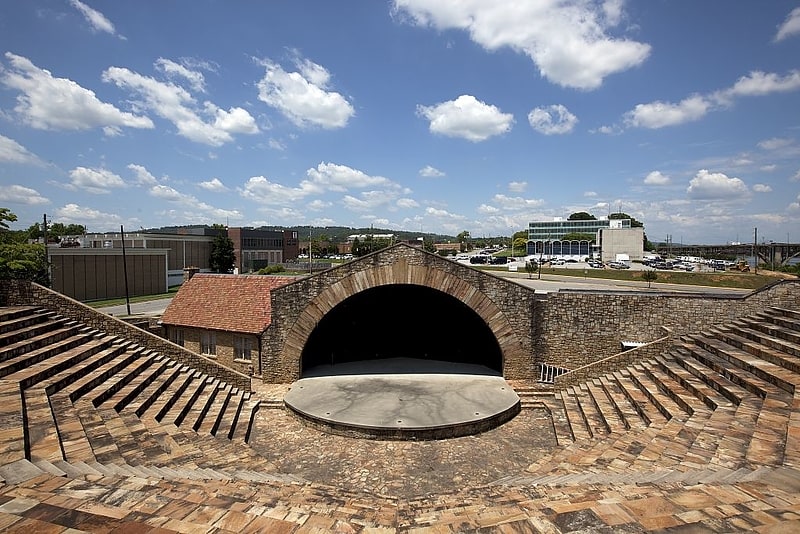
Amphitheater in Gadsden, Alabama. Mort Glosser Amphitheater is an amphitheatre in Gadsden, Alabama. Built in 1935, it was added to the National Register of Historic Places in 1988.[6]
Gadsden Downtown Historic District
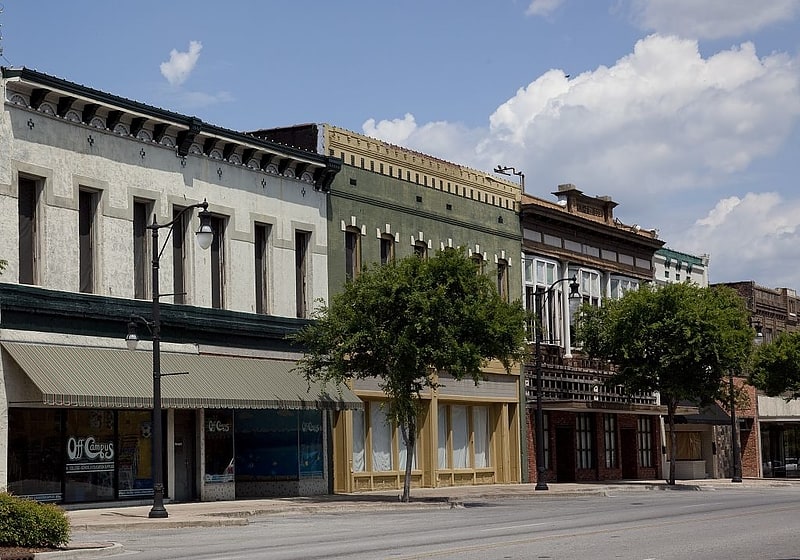
The Gadsden Downtown Historic District is a historic district in Gadsden, Alabama. The district represents the growth of the town through its industrial heyday from the late 1870s to the late 1940s. The earliest buildings in the district include examples of highly decorated Italianate styles, including the 1904 Gadsden Times-News Building. Early 20th-century buildings began showing less applied decoration, instead drawing visual variety from the brickwork itself. Later buildings begin to incorporate modern materials in their construction, including concrete, decorative glass, and enameled panels. There are three significant churches in the district that represent revivalist architectural styles:the Gothic Revival First Methodist Church, the Neoclassical First Baptist Church, and the Romanesque St. James Catholic Church. The Post Office and Courthouse, built in 1910, exhibits Italian Renaissance Revival style. The district was listed on the National Register of Historic Places in 1997.[7]
Charles Gunn House
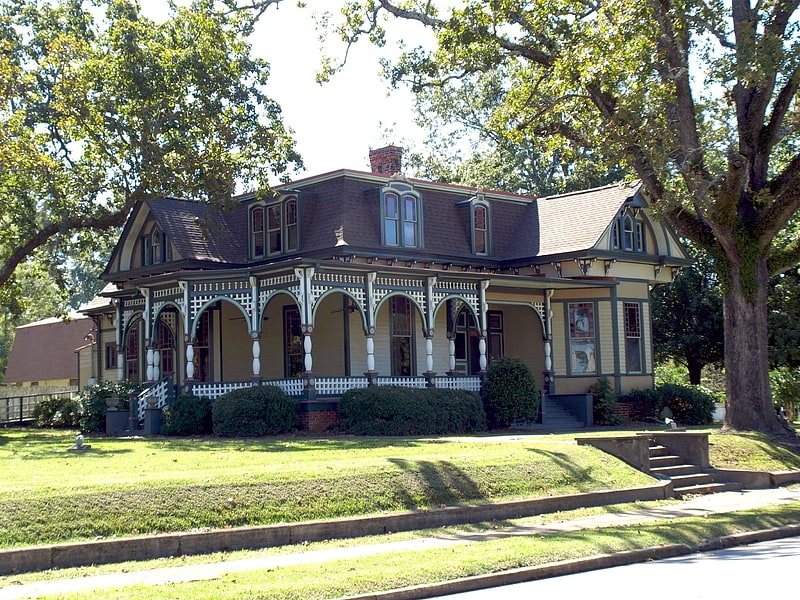
The Charles Gunn House is a historic residence in Gadsden, Alabama. The house was built in 1886 by Edward Tracy Hollingsworth, a local merchant and banker. Charles Logan Gunn, a dentist, purchased the house in 1901. His daughter, Carolyn Gunn Bellenger inherited the house, and willed it to the city upon her death in 1990. The city restored the house and now rents it for meetings and events.
The highly decorated Victorian house has a mansard roof with projecting gable atop a bay window on the north and east sides. The façade also features a wraparound porch with latticework balustrade. The house was listed on the Alabama Register of Landmarks and Heritage in 1984 and the National Register of Historic Places in 1993.[8]
Colonel O.R. Hood House
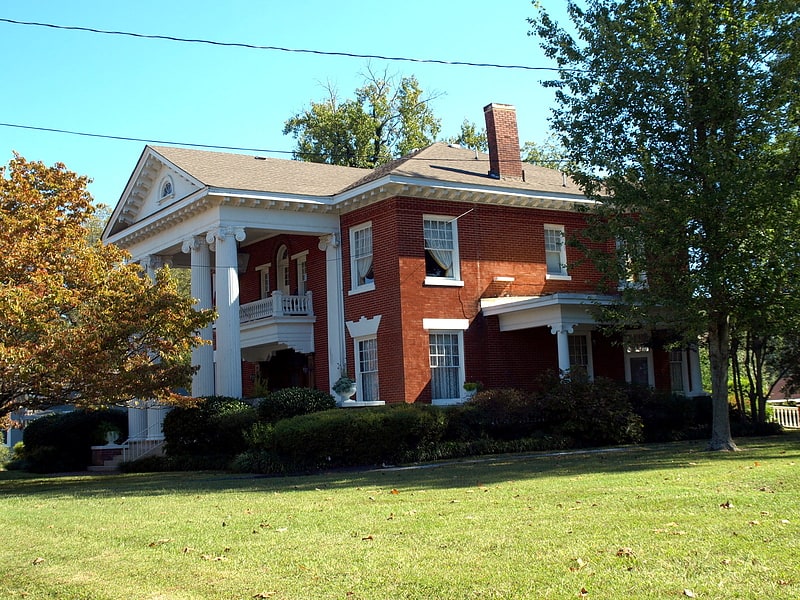
Heritage building in Gadsden, Alabama. The Colonel O. R. Hood House is a historic residence in Gadsden, Alabama. The house was built in 1904 by Oliver Roland Hood, an attorney, politician, industrialist, and one of the founders of the Alabama Power Company. He was also a delegate to the state's 1901 constitutional convention. It was designed and constructed by architect/builder James Crisman. Upon Hood's death in 1951, the house was purchased by the Woman's Club of Gadsden, a community service organization. The house is built in Classical Revival style with some Victorian details. The façade is dominated by a double-height portico supported by four Ionic columns. The front door is flanked by wide sidelights and a tall transom. The house also has two side entrances on octagonal bays at the rear of each side. The house was listed on the Alabama Register of Landmarks and Heritage in 1985 and the National Register of Historic Places in 1986.[9]